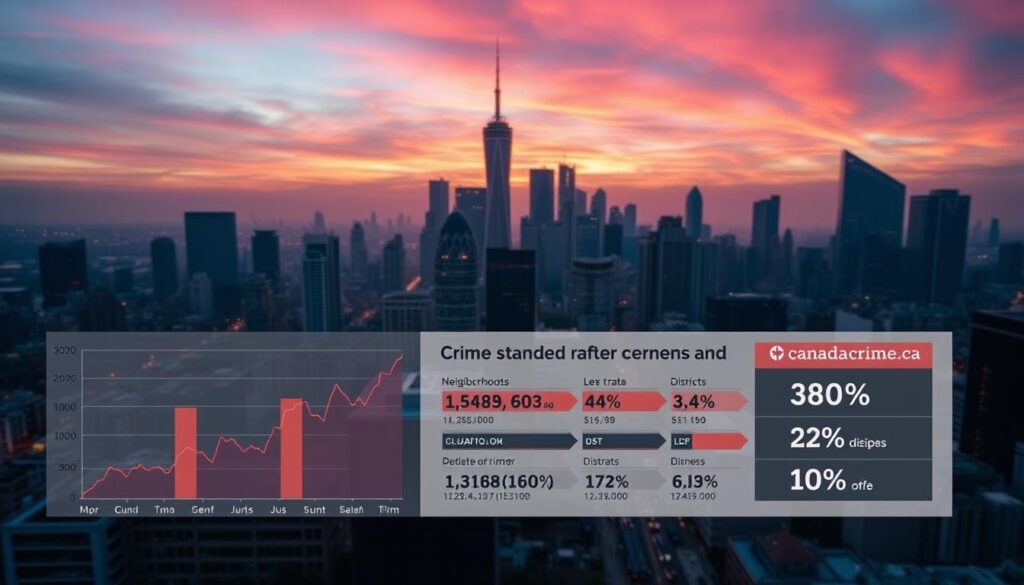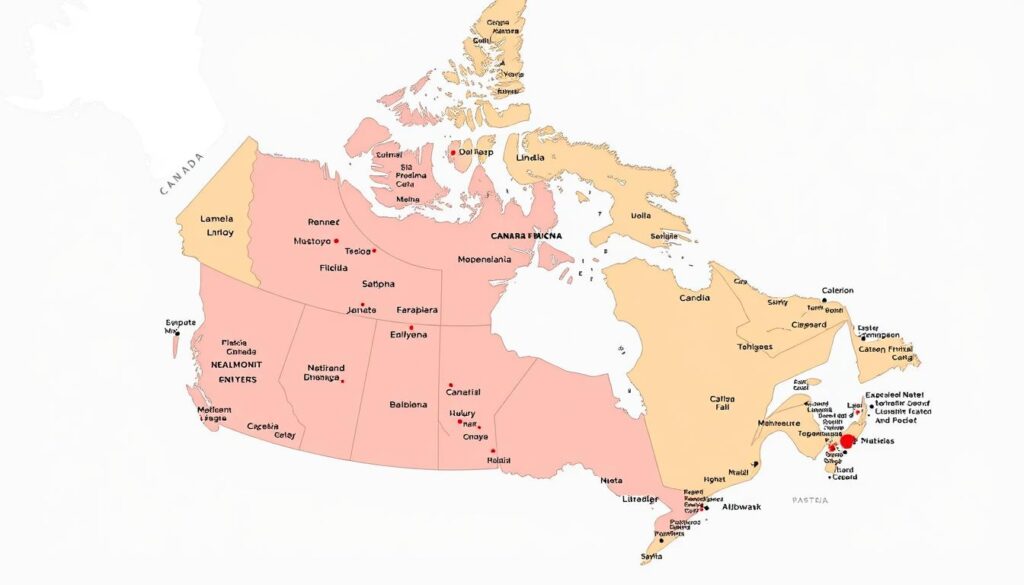Canada’s metropolitan regions exhibit a stark contrast in crime rates, with Winnipeg boasting one of the highest crime indexes at 60.5, while Quebec City enjoys a significantly lower rate at 22.2. This disparity highlights the complex nature of crime trends across the country.
Understanding the nuances of crime information is crucial for communities and policymakers to make informed decisions about public safety. By examining crime data across major Canadian cities, we can gain valuable insights into the prevalence of various types of criminal activities.
This comprehensive guide will delve into the crime statistics of Canadian cities, providing a detailed analysis of the factors contributing to regional differences in crime patterns.
Understanding Crime Rates in Canada
Understanding crime rates in Canada requires a nuanced approach, considering the diverse socio-economic factors at play. The data shows significant variations in crime rates across Canadian cities, with western cities like Winnipeg generally showing higher crime rates than eastern cities like Quebec City.
How Crime Statistics Are Measured in Canada
Crime statistics in Canada are measured using the Crime Severity Index (CSI), which takes into account the volume and severity of crimes reported to the police. This index provides a more comprehensive picture of crime trends than raw crime rates alone. For a detailed exploration of Canada’s crime rates and how they compare across different cities, visit Canada Crime Rates.

National Crime Trends in Recent Years
Canada has experienced fluctuating crime rates over the past decade. Recent years have seen modest increases in the national CSI after a long period of decline. Violent crime rates have garnered significant attention, with categories like sexual assault reporting increases. Meanwhile, property crimes continue to constitute the majority of criminal offenses, though their nature is evolving with increases in identity theft and cybercrime.
Regional disparities in crime trends are significant, with western provinces generally reporting higher rates than central and eastern provinces. The COVID-19 pandemic also created notable disruptions in crime patterns, with decreases in some categories like break-and-enters but increases in others like domestic violence.
Crime Statistics Across Major Canadian Cities

A closer look at Canada’s major cities reveals a complex picture of crime rates, influenced by various socio-economic factors. Understanding these variations is crucial for developing effective crime prevention strategies.
Winnipeg: Canada’s High-Crime Metropolitan Region
Winnipeg stands out as one of Canada’s cities with higher crime rates. Factors contributing to this include socio-economic challenges and urban decay in certain areas.
Saskatoon and Halifax: Medium-Risk Urban Centers
Saskatoon and Halifax represent medium-risk urban centers with crime rates that are neither exceptionally high nor low. These cities face unique challenges, including gang-related activities and property crimes.
Toronto and Vancouver: Crime in Canada’s Largest Cities
Toronto and Vancouver, being Canada’s largest cities, exhibit diverse crime patterns. While they have areas with higher crime rates, they also have significant portions with lower crime indices, reflecting their complex urban dynamics.
Quebec City and Montreal: Lower Crime Rate Areas
Quebec City and Montreal are notable for their relatively lower crime rates. Quebec City, in particular, is recognized for its safety, with a crime index of 22.2, making it one of the safest major cities in Canada.
Safest Major Cities in Canada
Some of the safest major cities in Canada include Quebec City (22.2 crime index), Burlington (29.7), Ottawa (31.3), and Oakville (26.1). These cities share characteristics such as strong community engagement, effective policing, and robust social services, contributing to their lower crime statistics.
- Quebec City consistently ranks as one of Canada’s safest major urban centers.
- Ottawa maintains a low crime index despite its size and status.
- Smaller suburban cities like Burlington and Oakville demonstrate that proximity to larger urban centers doesn’t necessarily correlate with higher crime rates.
Types of Crime and Their Prevalence in Canadian Cities
Crime statistics in Canada reveal a complex picture when broken down by city and type of crime. Understanding these variations is crucial for developing targeted crime prevention strategies and improving community safety.
Violent Crime Statistics
Violent crimes, including homicide, assault, and robbery, are a significant concern in many Canadian cities. While overall crime rates have fluctuated, violent crime remains a priority for law enforcement. Cities like Winnipeg have reported higher rates of violent crime compared to other major metropolitan areas.
Property Crime Rates
Property crimes, such as theft and vandalism, are among the most common types of crime in Canadian cities. Recent data shows that cities like Winnipeg and Saskatoon have reported property crime rates of 104.5 and 108.8 per 1,000 residents, respectively, with Winnipeg experiencing a decrease of 10.2% and Saskatoon a decrease of 0.8%. Halifax reported a rate of 62.6, with a slight increase of 2.3%.
| City | Property Crime Rate | Change |
|---|---|---|
| Winnipeg | 104.5 | -10.2% |
| Saskatoon | 108.8 | -0.8% |
| Halifax | 62.6 | +2.3% |
Drug-Related Offenses
Drug-related offenses have seen significant changes since the legalization of cannabis in 2018, with a notable decrease in possession charges. However, enforcement has shifted towards other substances like methamphetamine and opioids, particularly in Western Canadian cities. The community impact of drug-related activities extends beyond crime statistics, affecting perceptions of safety and neighborhood stability.

The relationship between drug offenses and other crime categories is complex, with substance use disorders correlating with certain property crimes and organized drug trafficking linked to violent offenses in some areas. Public health approaches have influenced how drug-related incidents are handled, with diversion programs and harm reduction strategies affecting crime statistics.
Canadian Crime Code and Classification System

The Canadian Crime Code and Classification System is a complex framework that plays a crucial role in understanding and addressing crime in Canada. This system is fundamental to the country’s criminal justice process, providing a standardized method for categorizing and reporting criminal incidents.
Understanding the Criminal Code of Canada
The Criminal Code of Canada is the cornerstone of the country’s crime classification system. It outlines various offenses and their corresponding classifications, providing a legal framework for law enforcement agencies to follow. The Code is regularly updated to reflect changes in societal values and legal precedents.
Key aspects of the Criminal Code include: definitions of various crimes, sentencing guidelines, and procedures for reporting and recording criminal incidents.
How Crimes Are Categorized and Reported
Crimes in Canada are categorized and reported using the Uniform Crime Reporting (UCR) Survey, a standardized framework provided by Statistics Canada. The UCR Survey ensures consistency in how criminal incidents are recorded across different police services.
- The Crime Severity Index (CSI) weights offenses based on court sentencing data, providing a nuanced measure of crime severity.
- The UCR uses a “most serious offense” rule when multiple offenses occur in a single incident.
- Violent Crime Index and Non-Violent Crime Index subcategories allow for more specific analysis of crime patterns.
- Clearance rates measure the proportion of reported crimes that are solved by police.
Factors Influencing Crime Rates in Canadian Cities
Various socioeconomic and environmental factors play a significant role in shaping crime rates across Canada’s city landscapes. Understanding these factors is crucial for developing effective crime prevention strategies.

Socioeconomic Factors
Socioeconomic factors significantly influence crime trends in Canadian urban centers. Factors such as unemployment rates, average income levels, and education can impact the prevalence of crimes. For instance, areas with higher unemployment tend to experience higher rates of property crime. Addressing these underlying socioeconomic issues is crucial for reducing overall crime rates.
Population Density and Urban Planning
The density of a city’s population and its urban planning strategies also play a critical role in determining crime rates. Cities with high population densities may experience higher rates of certain types of crimes if not managed properly through effective urban planning. Strategies such as improving street lighting, creating public spaces, and enhancing community facilities can contribute to safer urban environments.
Law Enforcement Resources and Strategies
The allocation of law enforcement resources and the strategies employed by police services significantly impact crime rates in Canadian city areas. Effective policing strategies, including community policing and targeted interventions in crime hotspots, can help reduce crimes and improve public safety. The use of technology, such as predictive policing tools, also influences crime detection and prevention efforts.
| Factor | Influence on Crime Rate | Example Strategies |
|---|---|---|
| Socioeconomic Factors | High unemployment and low income correlate with higher crime rates | Job creation programs, education initiatives |
| Population Density and Urban Planning | High density can increase crime if not properly managed | Improved street lighting, public spaces, community facilities |
| Law Enforcement Resources and Strategies | Effective policing reduces crime and improves safety | Community policing, targeted interventions, technology use |
As Canadian cities continue to evolve, understanding and addressing these factors will be crucial in maintaining low crime rates over the coming year. By adopting a multifaceted approach that includes socioeconomic support, urban planning, and effective law enforcement strategies, cities can work towards creating safer environments for their residents.
Comparing Canadian Cities to International Crime Statistics

Globally, Canadian cities are recognized for having lower crime rates compared to many other urban centers. This distinction is not merely coincidental but is rooted in various factors that contribute to the safety and security of Canadian urban environments.
Canadian vs. American Urban Crime Rates
One of the most telling comparisons is between Canadian and American cities. Studies have shown that Canadian cities generally have lower crime rates than their American counterparts. For instance, cities like Toronto and Vancouver have significantly lower violent crime rates compared to major U.S. cities like Chicago or Detroit. This disparity can be attributed to differences in gun control laws, social welfare policies, and community policing strategies.
Global Crime Index: Where Canadian Cities Rank
On the global stage, Canadian cities rank among the safest. Quebec City, with a crime index of 22.2, is considered one of the safest major cities worldwide, comparable to cities like Abu Dhabi and Dubai. Even Winnipeg, which has one of the higher crime rates among Canadian cities, ranks far safer than high-crime cities like Caracas or Pretoria. This global perspective underscores the relative safety of Canadian urban centers.
What Makes Canadian Cities Generally Safer
Several factors contribute to the lower crime rates in Canadian cities. Stricter gun control legislation is often cited as a key factor in reducing violent crime, particularly homicides and armed robberies. Additionally, Canada’s comprehensive social safety nets, including healthcare and education, may reduce motivations for crime related to economic desperation. Lower income inequality and effective immigration policies also play a role in maintaining safer communities.
Crime Prevention Strategies and Resources in Canada
Crime prevention in Canada involves community engagement, situational prevention, and early intervention. Various strategies have been implemented across Canadian cities to reduce crime rates. Community-based crime prevention programs have shown significant success, with neighborhood watch initiatives and youth engagement activities demonstrating measurable impacts on local crime rates.
Municipal governments across Canada have developed comprehensive safety strategies that coordinate efforts between police services, social agencies, businesses, and community organizations. For instance, the Government of Canada’s initiatives on crime prevention can be found on their official website at Public Safety Canada. These collaborative approaches have contributed to creating safer environments in various Canadian cities.
Furthermore, situational crime prevention strategies focus on reducing opportunities for criminal activity through environmental design and increased natural surveillance in public spaces. Early intervention programs targeting at-risk youth have also demonstrated long-term effectiveness in reducing criminal involvement. By combining these approaches, Canada continues to work towards reducing violent crime and improving overall safety.

